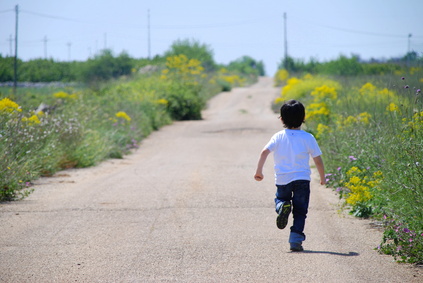Do you
- worry that your child will bolt or run off?
- have to chase after your child constantly to keep him safe?
- have a hard time walking through grocery stores or your neighborhood?
Many autism families have these problems. As a result we often find ourselves isolated at home and fearful of going beyond the fenced-in yard.
How nice it would be if our children could walk safely next to us, stop at corners and walk across the street on signal. I taught these skills to my nonverbal son with severe autism. TAGteach (Teaching with Acoustical Guidance) made this possible. You can teach these skills to your child too. Here’s how to do it, literally, one step at a time.
Look before you leap
It’s helpful to assess your child before teaching a new skill. To assess your child’s walking and running behaviors, download the free Child Observation Form or simply make notes on a sheet of paper. Take your child to a safe area, like the fenced-in yard, and spend five minutes observing his walking and running behavior.
Observe the legs and feet. How many steps does your child take in the same direction? Does he alternate walking, running or hopping? Does he alternate running quickly with running slowly? How frequently does he change direction? What are the walking problems you commonly encounter outside on the street or in a store? Describe the physical movements your child makes with legs and feet.
Set Tag Points
Study your notes and determine the first skill your child needs to learn. For example: my observation of my son revealed that he could not take more than one or two steps in the same direction. He was constantly spinning around and bolting off in another direction. This revelation showed me which skill he needed to learn first: continuous walking in the same direction. I set my first “tag point” as Two Steps in Same Direction. When this skill was mastered, we moved on to the next. Here are the four tag points I worked on to teach my son Safe Walking:
- Two Steps in Same Direction
- Walk Beside Me
- Two Feet on Ground (Stop)
- Stand/Wait
Two Steps in Same Direction
The first tag point that I set for my son was: Two Steps in Same Direction. I watched his feet. If his first step was in one direction, I waited to see if the second footstep was in the same direction. If it was in the same direction, I tagged and reinforced the behavior. If not, I waited to see what the next step would look like.
My goal was to teach him the behavior of moving in a consistent direction. This went quickly. Soon he was doing Two Steps in Same Direction consistently, so I changed the tag point to Three Steps in Same Direction, and tagged at the precise moment he made the third step. Before I knew it the tag point was Four Steps in Same Direction, then Five Steps in Same Direction. By then we were able to take a walk around the block!
Walk Beside Me
Once a child is walking reliably in the same direction, you want to be sure that he will stay beside you. The tag point for this is Walk Beside Me. While my son and I were out walking, every time he walked beside me within arm’s length, I tagged and treated. My son quickly learned to stay by my side. With these two skills mastered, we started having a nice time going to the park.
Two Feet on Ground (Stop)
Now your child is moving and he’s walking with you. That’s great! But, we often need to stop at corners or crosswalks, so it’s important that your child learns to stop and, especially, to stop on cue. Teaching Stop is easy. You tag and reinforce every time your child has Two Feet On Ground. This behavior will happen naturally during the course of a walk, so tag and reinforce it every time. Your child will increase his stopping behavior. The important part is teaching him to do it on cue when you say or sign, “Stop.”
Put this behavior on cue by saying or signing “Stop” every time your child stops. He will associate the sound with the behavior and, with time and practice, will learn to stop when you give him the cue. I always took pains to say “Stop” in a happy, cheerful voice to show that I was pleased with his stopping behavior. He learned that “Stop” was another opportunity to experience success and receive reinforcement, so he was happy to do it. Since “Stop” is such an important behavior, it’s important to monitor it closely and reinforce it often.
Stand/Wait
This skill is important because our kids need to be able to wait at street corners and in the check-out line at the grocery store. The Stand/Wait tag point is basically an extension of the Stop/Two Feet on Ground tag point discussed above, but with duration. I wanted my son to stand for longer than a split second, preferably for at least 10-15 seconds, and eventually for 3-4 minutes in the grocery store check-out line. To teach Stand/Wait, I observed my son’s Feet on Ground behavior and tagged and reinforced it when he stopped for longer than usual. I started out with Stop/Wait Three Seconds and worked up from there.
To keep track of how long he was standing still, I counted out loud, “one, two, three” and tagged and reinforced if he could stand still that long. He got big treats and lots of praise if he could do it. Then, we made it a game: I challenged him to stand still while I counted to four, five and so on. We used counting games, nursery rhymes, and lyrics from songs to keep him occupied.
I had fun with my child, kept him engaged with words and numbers, and most importantly, kept him standing until it was time to cross the street or pay the store clerk.
Freedom!
Learning these four tag points led to freedom! After this, our lives changed. We could take a walk around the block. We could go out and enjoy the park and the playground. Even better, we could go to the grocery store and the mall.
 Health benefits!
Health benefits!
In addition to safety, walking has huge health benefits. Many kids with autism do not get enough exercise. Walking is a simple, inexpensive activity that a family can do almost anywhere. Once a child is a skilled walker, the whole family can go out, enjoy nature, and get some fresh air.
How long did this take?
We worked on these tag points a few days each week. After five months my son changed from being a dangerous bolter to being able to take 5-mile hikes with a local hiking club.
Review of tag points
Just to review, here are the tag points for teaching safe walking skills:
- Two Steps, Same Direction
- Walk With Me
- Two Feet on Ground (Stop)
- Stand/Wait
What is TAGteach?
TAGteach stands for Teaching with Acoustical Guidance. TAGteach is a teaching and communication method based on the scientific principles of Applied Behavior Analysis (ABA).
TAGteach enables extremely precise positive reinforcement of behavior by using an acoustical signal to “mark” a behavior – at the precise moment the child performs the behavior! The acoustical signal is a short, sharp sound made by a handheld device (the “tagger”). When the child performs the correct action, the parent/instructor immediately presses the button on the tagger and hands over a treat (candy, treat, token, praise, social recognition, or money) as a reinforcer.
With TAGteach, it is easy to reinforce behaviors precisely, quickly, and intensively. The immediate, accurate feedback and positive reinforcement result in the child performing the correct action more often, and for longer periods of time. With immediate feedback and learning tasks broken down into small steps, children (and adults) can learn many new skills with TAGteach — at their own pace.
To learn more about this effective, low-cost method visit TAGteach International or Chaos to Calm
For research on TAGteach, please see the TAGteach Reference List
Join the free TAGteach for Learning, Behavior, and Autism Facebook group
TAGteach taggers available here and i-Clicks available here
See Martha’s book about TAGteach for Autism or feel free to ask me a question (with no obligation).
Sign up for my mailing list to receive updates, new articles and free tips right in your inbox!
If you liked this post, please share it. Thank you!


Amazing!